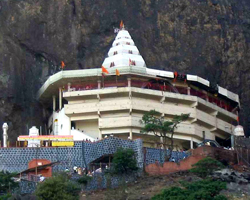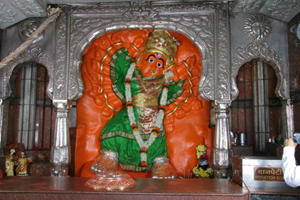


Saptshrungi Devi ( Vani )
Click Here for Online Payment
 Hindu almanac considers three and half days as highly auspicious. They are Gudipadwa - Hindu's New Year, Dushhera, Diwali and Akshaytritiya. Likewisedwelling places of Goddesses in Maharashtra are famous. Tuljapur where Tulja Bhawani dwells, Kolhapur, the dwelling place of Ambabhavani, and Mahur where Kulaswamini dwells. Saptashringa Garh where Goddess Bhagawati dwells is half as important as any of the earlier mentioned places of Goddesses in Maharashtra. Saptashringa means the mountain having seven peaks. It is around 55 kms away from Nashik.
Nanduri village is situated at the foot of the Saptashringa Garh. The road to the temple is zig - zag and climbs around 11 kms till it reaches the top. In front of the temple there stands Markandeya Rishi's (sage) hill. The Saptashringa Garh is full of a variety of trees having medicinal worth. As per the story in the epic Ramayana, Hanuman carried the herbal medicine for wounded Laxmana from this hill. There are about 108 water reservoirs on the hill. They are called as Kundas..
Hindu almanac considers three and half days as highly auspicious. They are Gudipadwa - Hindu's New Year, Dushhera, Diwali and Akshaytritiya. Likewisedwelling places of Goddesses in Maharashtra are famous. Tuljapur where Tulja Bhawani dwells, Kolhapur, the dwelling place of Ambabhavani, and Mahur where Kulaswamini dwells. Saptashringa Garh where Goddess Bhagawati dwells is half as important as any of the earlier mentioned places of Goddesses in Maharashtra. Saptashringa means the mountain having seven peaks. It is around 55 kms away from Nashik.
Nanduri village is situated at the foot of the Saptashringa Garh. The road to the temple is zig - zag and climbs around 11 kms till it reaches the top. In front of the temple there stands Markandeya Rishi's (sage) hill. The Saptashringa Garh is full of a variety of trees having medicinal worth. As per the story in the epic Ramayana, Hanuman carried the herbal medicine for wounded Laxmana from this hill. There are about 108 water reservoirs on the hill. They are called as Kundas..
Idol of Goddess
 Saptashringi Goddess is known as Khandesh's Goddess. Devotees from Chalisgaon, Jalgaon, Malegaon and Dhulia visit this temple frequently. The idol of the Goddess is set at a height, so that she can be seen from a distance too. She has 9 pairs of arms, holding different weapons. Her sparkling eyes, slightly inflated nostrils wearing Nath (an ornament to be worn in the nose) and 18 hands look very attractive.Every full moon day and during Navaratri the temple is crowded with devotees. The Goddess is offered coconuts and sarees. The Goddess is also called as Mahishasur Mardini. A story in this connection is that Demon Mahishasur was creating problem for Markendaya Rishi. Markendaya had made a Holy Fire to eliminate him. The Goddess emerged with 9 pairs of arms holding different weapons from theoly Fire and eliminated the Demon. Hence Mahishasur Mardini, meaning the one who slayed Mahishasur.
Saptashringi Goddess is known as Khandesh's Goddess. Devotees from Chalisgaon, Jalgaon, Malegaon and Dhulia visit this temple frequently. The idol of the Goddess is set at a height, so that she can be seen from a distance too. She has 9 pairs of arms, holding different weapons. Her sparkling eyes, slightly inflated nostrils wearing Nath (an ornament to be worn in the nose) and 18 hands look very attractive.Every full moon day and during Navaratri the temple is crowded with devotees. The Goddess is offered coconuts and sarees. The Goddess is also called as Mahishasur Mardini. A story in this connection is that Demon Mahishasur was creating problem for Markendaya Rishi. Markendaya had made a Holy Fire to eliminate him. The Goddess emerged with 9 pairs of arms holding different weapons from theoly Fire and eliminated the Demon. Hence Mahishasur Mardini, meaning the one who slayed Mahishasur.


